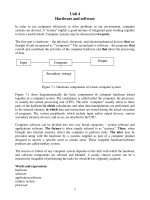Real options analysis course business cases and software applications
Bạn đang xem bản rút gọn của tài liệu. Xem và tải ngay bản đầy đủ của tài liệu tại đây (5.5 MB, 318 trang )
Real Options
Analysis Course
Founded in 1807, John Wiley & Sons is the oldest independent publishing
company in the United States. With offices in North America, Europe, Aus-
tralia, and Asia, Wiley is globally committed to developing and marketing
print and electronic products and services for our customers’ professional
and personal knowledge and understanding.
The Wiley Finance series contains books written specifically for finance and
investment professionals as well as sophisticated individual investors and
their financial advisors. Book topics range from portfolio management to
e-commerce, risk management, financial engineering, valuation and finan-
cial instrument analysis, as well as much more.
For a list of available titles, visit our Web site at www.WileyFinance.com.
Real Options
Analysis Course
Business Cases and Software Applications
JOHNATHAN MUN
John Wiley & Sons, Inc.
This book is printed on acid-free paper.
Copyright © 2003 by Johnathan Mun. All rights reserved.
Published by John Wiley & Sons, Inc., Hoboken, New Jersey.
Published simultaneously in Canada.
No part of this publication may be reproduced, stored in a retrieval system, or
transmitted in any form or by any means, electronic, mechanical, photocopying,
recording, scanning, or otherwise, except as permitted under Section 107 or 108 of
the 1976 United States Copyright Act, without either the prior written permission
of the Publisher, or authorization through payment of the appropriate per-copy fee
to the Copyright Clearance Center, Inc., 222 Rosewood Drive, Danvers, MA
01923, 978-750-8400, fax 978-750-4470, or on the Web at www.copyright.com.
Requests to the Publisher for permission should be addressed to the Permissions
Department, John Wiley & Sons, Inc., 111 River Street, Hoboken, NJ 07030, 201-
748-6011, fax 201-748-6008, e-mail:
Limit of Liability/Disclaimer of Warranty: While the publisher and author have
used their best efforts in preparing this book, they make no representations or
warranties with respect to the accuracy or completeness of the contents of this
book and specifically disclaim any implied warranties of merchantability or fitness
for a particular purpose. No warranty may be created or extended by sales repre-
sentatives or written sales materials. The advice and strategies contained herein
may not be suitable for your situation. You should consult with a professional
where appropriate. Neither the publisher nor author shall be liable for any loss of
profit or any other commercial damages, including but not limited to special, inci-
dental, consequential, or other damages.
For general information on our other products and services, or technical support,
please contact our Customer Care Department within the United States at 800-
762-2974, outside the United States at 317-572-3993 or fax 317-572-4002.
Wiley also publishes its books in a variety of electronic formats. Some content that
appears in print may not be available in electronic books.
For more information about Wiley products, visit our web site at www.wiley.com.
Crystal Ball and Real Options Analysis Toolkit are registered trademarks of
Decisioneering, Inc.
Microsoft is a registered trademark of Microsoft Corporation.
Library of Congress Cataloging-in-Publication Data:
Mun, Johnathan.
Real options analysis course : business cases and software applications /
Johnathan Mun.
p. cm.
Published simultaneously in Canada.
ISBN 0-471-43001-3 (Cloth/CD-Rom : alk. paper)
1. Real options (Finance) I. Title: Business cases and software applications (with
real options toolkit software CD-Rom). II. Title.
HG6042 .M855 2003
332.63—dc21
2002153126
Printed in the United States of America.
10987654321
v
Preface
I
wrote this book with the corporate financial analyst and graduate student
in mind. Real Options Analysis Course’s business cases, exercises, step-by-
step methodologies, and applications have been adapted for and solved
using the enclosed Real Options Analysis Toolkit trial software CD-ROM.
It is assumed that the reader has familiarity with real options concepts as
outlined in my previous book, Real Options Analysis (Wiley, 2002), as some
of the more important concepts overlap between these books. As in the first
book, I focus on the ease of use and pragmatic applications of real options
and forgo many of the theoretical concepts. The idea is to demystify the
black-box analytics in real options and to make transparent its concepts,
methodologies, and applications. Rather than relying on stochastic Ito cal-
culus, variance reduction, differential equations, numerical methods, or sto-
chastic path-dependent simulations to solve real options problems, I have
instead relied heavily on binomial lattices, which I have shown time and
again to be reliable and produce identical results, at the limit, to the former
approaches. While it is extremely easy to modify binomial lattices depend-
ing on the real options or to more accurately mirror the intricacies of actual
business cases, it is extremely difficult to do so using the more advanced
techniques. In the end, the more flexible and mathematically manageable
approach becomes the pragmatic approach. The flexibility in the modeling
approach flows well with the overall theme of this book: “If you can think
it, you can solve it!” Finally, my intention is to reveal as much as possible in
the realms of real options. A black box will remain a black box if no one can
understand the concepts, despite its power and applicability. Only when the
black box becomes so transparent that analysts can understand, apply, and
convince others of its results and applicability will the approach receive
widespread influence. It took over two decades for discounted cash flow and
net present value analysis to take hold in corporate finance—then again, that
was during an era of slide rules, little knowledge of corporate finance, and
virtually no desktop computer software spreadsheet applications. However,
it is vital to note that the software does not eliminate the analyst, as it is only
a tool. Instead, the tool exists to allow the analyst to spend more time think-
ing and framing the real options problem—50 percent of the real options
challenge is simply thinking about it, 25 percent is the modeling, and the re-
maining 25 percent is explaining the results to management. I am convinced
that with the advent of my software, Real Options Analysis Toolkit, books
such as this one (that demystifies real options, rather than cloud it with ac-
ademic jargon and unnecessary complexities), and seminars and trainings
like the ones I have held worldwide, the learning curve will be traversed even
more quickly and real options will be accepted as widely as discounted cash
flow modeling within the next few decades.
J
OHNATHAN
M
UN
, P
H
.D.
Denver, Colorado
February 2003
vi PREFACE
vii
About the Author
D
r. Johnathan C. Mun is currently the vice president of Analytical
Services at Decisioneering, Inc., the makers of Real Options Analysis
Toolkit and the Crystal Ball suite of products, including applications
of Monte Carlo simulation, optimization, and forecasting. He heads up
the development of real options and financial analytics software prod-
ucts, analytical consulting, training, and technical support. He is also a
Visiting and Adjunct Professor and has taught courses in financial man-
agement, investments, real options, economics, and statistics at the un-
dergraduate and the graduate M.B.A. levels. He has taught at universities
all over the world, from the University of Applied Sciences (Switzerland)
to Golden Gate University (California) and St. Mary’s College (Califor-
nia). Prior to joining Decisioneering, he was a consulting manager and
financial economist in the Valuation Services and Global Financial Ser-
vices practice of KPMG Consulting (now Bearing Point) and a manager
with the Economic Consulting Services practice at KPMG LLP. He has
extensive experience in econometric modeling, financial analysis, real
options, economic analysis, forecasting, and statistics. During his tenure
both at Decisioneering and at KPMG Consulting, he consulted on real
options and financial valuation for many Fortune 100 firms. His experi-
ence prior to joining KPMG included being department head of financial
planning and analysis at Viking Inc. of FedEx, performing financial fore-
casting, economic analysis, and market research. Prior to that, he had
also performed some financial planning and freelance financial consult-
ing work.
Dr. Mun received his Ph.D. in finance and economics from Lehigh
University, where his research and academic interests were in the areas of
investment finance, econometric modeling, financial options, corporate
finance, and microeconomic theory. He also has an M.B.A. from Nova
Southeastern University and a B.S. in biology and physics from the Uni-
versity of Miami. He is certified in financial risk management (FRM) and
in financial consulting (CFC), and is currently a Level III candidate for
the Chartered Financial Analyst (CFA) Program. He is a member of the
American Mensa, Phi Beta Kappa Honor Society, and Golden Key
Honor Society, as well as several other professional organizations,
including the Eastern and Southern Finance Associations, American
Economic Association, and Global Association of Risk Professionals.
Finally, he has written many academic articles published in the Journal
of the Advances in Quantitative Accounting and Finance, The Global
Finance Journal, The International Financial Review, The Journal of
Financial Analysis, Journal of the Society of Petroleum Engineers, and
Financial Engineering News.
viii ABOUT THE AUTHOR
ix
Contents
CHAPTER 1
Installing the Software 1
Installing Crystal Ball Monte Carlo
Simulation Software 1
Installing Real Options Analysis Toolkit Software 8
CHAPTER 2
Getting Started with the Software 15
Getting Started with Crystal Ball Software 15
Getting Started with Real Options Analysis
Toolkit Software 22
CHAPTER 3
Framing Real Options 39
Step 1: Qualify List of Projects and Strategies 40
Step 2: Forecast Base-Case Variables for Each Project 41
Step 3: Create Static DCF Models for Each Case 42
Step 4: Monte Carlo Simulation—DCF Outputs Become
Real Options Inputs 43
Step 5: Framing the Real Options 46
Step 6: Options Analytics, Simulation,
and Optimization 54
Step 7: Reports, Presentations, and Update Analysis 55
CHAPTER 4
The Basics of Financial Modeling 57
Financial Analysis 57
Monte Carlo Simulation 61
Volatility Estimates 64
CHAPTER 5
The Basics of Real Options 73
Binomial Lattices 73
Granularities in Lattices 77
State-Pricing Approach to Solving a European Option 88
Trinomial Lattices and American Options 90
CHAPTER 6
Real Options Business Cases 95
Option to Abandon 95
Option to Expand 105
Option to Contract 117
Option to Choose 126
Compound Options 136
Closed-Form Compound Options 144
Sequential Compound Option 148
Changing Costs 154
Changing Volatility 158
Option to Contract and Abandon 162
Basic Black-Scholes with Dividends 167
Barrier Options 171
Stochastic Timing Options 175
Switching Option 178
Closed-Form Equations and Binomial Convergence 183
Nonrecombining Lattices 189
CHAPTER 7
Extended Problems: Combining Forecasting, DCF Modeling,
Real Options, and Optimization 201
CHAPTER 8
Exercise Solutions 213
CHAPTER 9
Real Options Analysis Toolkit Software Function
Description for Excel 239
x CONTENTS
CHAPTER 10
Real Options Tables 251
Real Options Value Tables 251
Implied Volatility Tables 266
Dividend Impact Tables 272
APPENDIX
Case Studies 281
More, Faster, Cheaper—The Siren Call
of Upstream R&D 281
Real Options Analysis Applied to Valuing
Start-Up Entities: The Digital News, Inc. 284
INDEX 295
Contents xi
Real Options
Analysis Course
1
CHAPTER
1
Installing the Software
INSTALLING CRYSTAL BALL MONTE CARLO
SIMULATION SOFTWARE
To get started with the business cases, you first have to install the Crystal
Ball
®
Monte Carlo simulation software. The Crystal Ball software needs to be
installed prior to installing the Real Options Analysis Toolkit software cov-
ered in the next section. You do not have to install Crystal Ball if you have a
previous version already installed. The version of Crystal Ball on the accom-
panying CD-ROM requires a minimum of Microsoft Windows 2000 or later,
Microsoft Excel 97 or later, 10 MB hard drive space, and 64 MB RAM to run.
Exit all other programs before starting the installation process. To start
the installation process, browse the contents of the CD-ROM. Open the
Crystal Ball Software folder and double-click on the setup.exe file (Figure
1.1). You will then be greeted with an installation welcome screen as seen in
FIGURE 1.1 Setup folder contents for Crystal Ball software.
Figure 1.2. Click on the Next button to continue with the installation
process.
The installation process will then prompt you for your name, company
name, and a registration number as seen in Figure 1.3. Leave the registration
code field empty for a trial period, or enter a valid registration number if you
have purchased a full version of the software. Click on the Next button to
continue with the installation process. You will then be prompted with sev-
eral installation and start-up preferences. For simplicity, select the recom-
2 INSTALLING THE SOFTWARE
FIGURE 1.2 Program setup welcome screen.
FIGURE 1.3 Registration screen.
mended default setup settings, that is, set Crystal Ball to start every time Mi-
crosoft Excel is launched. Click on the Next button to continue with the in-
stallation process (Figure 1.4).
The installer will automatically locate the directory where Microsoft
Excel resides. If you have multiple versions of Microsoft Excel and you wish
to use Crystal Ball only with a particular version, then click on the Browse
button to locate the folder with the specific version of Microsoft Excel.
Otherwise, click on the Next button to continue (Figure 1.5). Choose the
Installing Crystal Ball Monte Carlo Simulation Software 3
FIGURE 1.4 Start option configuration screen.
FIGURE 1.5 Microsoft Excel location prompt at setup.
destination folder to install the software. Unless there are specific reasons,
such as low disk space or installing on servers, use the default installation lo-
cation and click on Next (Figure 1.6).
You will then be prompted to select the components to install. Crystal
Ball 2000 is a required component to run simulations. CB Predictor is a
time-series forecasting utility. Crystal Ball Tools is a collection of power
tools ranging from Tornado Charts and Sensitivity Analysis to Nonpara-
metric Bootstrap Simulation. OptQuest for Crystal Ball is a stochastic opti-
mization tool. Developer Kit for Crystal Ball is a collection of functions
available through Visual Basic for Applications (VBA) in Microsoft Excel.
Keep the default settings to select all the components for installation and
click Next (Figure 1.7). When the installation is complete, you will be noti-
fied (Figure 1.8). Click on Finish to complete and exit the process. The en-
tire installation process may take from 3 minutes to 10 minutes, depending
on the speed of your computer.
Now, to verify that the installation procedure has been successful, click
on the Start button in Microsoft Windows, select Programs and Crystal
Ball. You will then see some supporting materials including examples and
help files. Click on Crystal Ball to launch the software (Figure 1.9). When
the software starts for the very first time, you will see an end-user license
agreement (Figure 1.10). Read through the agreement and click on Accept to
get started. If the installation process had been successful, you will see the
Crystal Ball splash screen appear momentarily (Figure 1.11).
The software will also start Microsoft Excel. You should notice a new
Crystal Ball icon toolbar in Microsoft Excel (Figure 1.12). In addition, three
4 INSTALLING THE SOFTWARE
FIGURE 1.6 Choose setup location screen.
5
FIGURE 1.7 Component selection screen at setup.
FIGURE 1.8 Setup completion verification screen.
FIGURE 1.9 Location of the Crystal Ball software.
new menu bar items will be added to Microsoft Excel (Figure 1.13). If these
elements do not appear, click on Tools and select Add-Ins (Figure 1.14).
Make sure the box beside Crystal Ball is checked and click OK (Figure
1.15). You are now ready to install the Real Options Analysis Toolkit soft-
ware and begin the exercises. Refer to Chapter 2, Getting Started with the
Software, to begin using the software.
6 INSTALLING THE SOFTWARE
FIGURE 1.10 License acceptance screen.
FIGURE 1.11 Crystal Ball splash screen.
FIGURE 1.12 Crystal Ball icon bar.
7
FIGURE 1.13 Crystal Ball menu bar in Microsoft Excel.
FIGURE 1.14 Menu item in Microsoft Excel.
FIGURE 1.15 Add-ins dialog box in Microsoft Excel.
INSTALLING REAL OPTIONS ANALYSIS
TOOLKIT SOFTWARE
I recommend that you install the Crystal Ball software before installing the
Real Options Analysis Toolkit, and that you exit all other programs before
starting the installation process. To start the installation process, browse the
contents of the CD-ROM. Open the Real Options Software folder and
double-click on the setup.exe file (Figure 1.16). (You need to have adminis-
trative rights before you can install the software. Please see an IT profes-
sional if you are unsure if you have these rights on the computer.)
The installer then searches your computer for the Microsoft .NET
Framework, a required component to run the Real Options Analysis Toolkit
software. If the Microsoft .NET Framework does not exist, you will be
prompted to install it by first accepting the Microsoft licensing agreement
(Figure 1.17). Confirm the installation of the Microsoft .NET Framework
package by selecting Yes when prompted (Figure 1.18). Then, simply follow
the instructions by keeping all the default settings and clicking on Next
when prompted (Figure 1.19). You will be updated on the amount of time
remaining during the installation process (Figure 1.20), and notified when
the installation is complete (Figure 1.21). Depending on your system con-
figuration, the installation process for the Microsoft .NET Framework may
take from 3 minutes to 20 minutes.
8 INSTALLING THE SOFTWARE
FIGURE 1.16 Setup folder contents for Real Options Analysis Toolkit software.
9
FIGURE 1.17 License acceptance screen.
FIGURE 1.18 Microsoft .NET Framework installation confirmation.
FIGURE 1.19 Microsoft .NET Framework setup screen.
After the Microsoft .NET Framework is installed, the Real Options
Analysis Toolkit software installation starts automatically. If it does not,
simply rerun the setup.exe file by double-clicking on the file located in
the Real Options folder. Click on Next to continue with the installation (Fig-
ure 1.22).
Read the end-user licensing agreement and click Yes if you agree with
the statement and to continue with the installation process (Figure 1.23).
Then, enter your name and company name, and click Next to continue
10 INSTALLING THE SOFTWARE
FIGURE 1.20 Microsoft .NET Setup status screen.
FIGURE 1.21 Microsoft .NET Setup completion verification screen.









